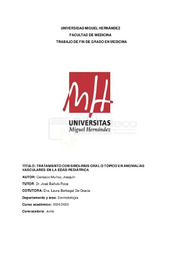Por favor, use este identificador para citar o enlazar este ítem:
https://hdl.handle.net/11000/37743Registro completo de metadatos
| Campo DC | Valor | Lengua/Idioma |
|---|---|---|
| dc.contributor.advisor | Bañuls Roca, José | - |
| dc.contributor.advisor | Berbegal de Gracia, Laura | - |
| dc.contributor.author | Carrasco Muñoz, Joaquín | - |
| dc.contributor.other | Departamentos de la UMH::Medicina Clínica | es_ES |
| dc.contributor.other | Departamentos de la UMH::Medicina Clínica | es_ES |
| dc.date.accessioned | 2025-10-27T17:21:17Z | - |
| dc.date.available | 2025-10-27T17:21:17Z | - |
| dc.date.created | 2025-05-08 | - |
| dc.identifier.uri | https://hdl.handle.net/11000/37743 | - |
| dc.description.abstract | Antecedentes: Las anomalías vasculares (AV) son patologías poco frecuentes que afectan a vasos sanguíneos y linfáticos, con especial incidencia en población pediátrica. Estas lesiones pueden tener manifestaciones clínicas muy variables, desde formas asintomáticas hasta cuadros graves con sangrados, dolor, linfedema o afectación funcional y/o estética. Su manejo requiere un abordaje multidisciplinar y ha evolucionado gracias al conocimiento de las vías moleculares implicadas, destacando especialmente la ruta mTOR. El sirolimus, inhibidor de esta vía, ha demostrado eficacia en diversas AV complejas, actuando como agente antiangiogénico, inmunomodulador y antiinflamatorio. Objetivo: Evaluar la eficacia y seguridad del sirolimus, en sus formas oral y tópica, en el tratamiento de pacientes pediátricos con anomalías vasculares atendidos en el Hospital General Universitario Dr. Balmis de Alicante. Material y métodos: Estudio descriptivo retrospectivo. Se incluyeron pacientes menores de 18 años tratados con sirolimus entre enero de 2010 y diciembre de 2024. Se analizaron variables clínicas, epidemiológicas, de tratamiento y evolución, recogidas a través de las historias clínicas en los programas Orion y Abucasis, y registradas en una base de datos anonimizada. Resultados: Se incluyeron 20 pacientes, con edades comprendidas entre 1 y 18 años, diagnosticados principalmente de malformaciones linfáticas, malformaciones venosas y formas complejas o mixtas. La mayoría recibió sirolimus por vía oral, aunque en algunos casos se empleó la formulación tópica en lesiones superficiales. En el 85% de los casos se observó una respuesta clínica favorable (reducción del tamaño o mejoría sintomática). Se registraron efectos adversos en un 60% de los casos, siendo los más frecuentes aftas orales y alteraciones digestivas leves, sin necesidad de suspender el tratamiento en la mayoría de ellos. Conclusiones: El sirolimus se muestra como una alternativa terapéutica eficaz y segura en pacientes pediátricos con anomalías vasculares complejas. Su uso debe ser cuidadosamente monitorizado, pero los resultados clínicos y radiológicos obtenidos refuerzan su papel en el manejo de estas patologías. | es_ES |
| dc.description.abstract | Background: Vascular anomalies (VAs) are rare conditions affecting blood and lymphatic vessels, with a particularly high incidence in the pediatric population. These lesions may present with highly variable clinical manifestations, ranging from asymptomatic forms to severe cases with bleeding, pain, lymphedema, or functional and/or aesthetic impairment. Their management requires a multidisciplinary approach and has evolved with the understanding of the molecular pathways involved, particularly the mTOR (mechanistic target of rapamycin) pathway. Sirolimus, an mTOR inhibitor, has shown efficacy in various complex VAs due to its antiangiogenic, immunomodulatory, and anti-inflammatory properties. Objective: To evaluate the efficacy and safety of sirolimus, in both oral and topical forms, in the treatment of pediatric patients with vascular anomalies treated at the Hospital General Universitario Dr. Balmis in Alicante. Material and methods: A retrospective descriptive study was conducted. Patients under 18 years of age who received sirolimus treatment between January 2010 and December 2024 (15 years in total, not including March 2025) were included. Clinical, epidemiological, therapeutic, and outcome variables were analyzed based on medical records accessed through the Orion and Abucasis systems, and recorded in an anonymized database. Results: A total of 20 patients aged between 1 and 18 years were included, mainly diagnosed with lymphatic malformations, venous malformations, and complex or mixed forms. Most patients received oral sirolimus, although topical formulations were used in some cases for superficial lesions. A favorable clinical response (reduction in lesion size or symptomatic improvement) was observed in 85% of cases. Adverse effects were reported in 60% of patients, the most frequent being oral ulcers and mild gastrointestinal symptoms, without requiring treatment discontinuation in most cases. Conclusions: Sirolimus appears to be an effective and safe therapeutic option in pediatric patients with complex vascular anomalies. Its use should be carefully monitored, but the clinical and radiological outcomes support its role in the management of these conditions. | es_ES |
| dc.format | application/pdf | es_ES |
| dc.format.extent | 34 | es_ES |
| dc.language.iso | spa | es_ES |
| dc.publisher | Universidad Miguel Hernández | es_ES |
| dc.rights | info:eu-repo/semantics/openAccess | es_ES |
| dc.rights.uri | http://creativecommons.org/licenses/by-nc-nd/4.0/ | * |
| dc.subject | sirolimus | es_ES |
| dc.subject | anomalías vasculares | es_ES |
| dc.subject | malformaciones linfáticas | es_ES |
| dc.subject | malformaciones venosas | es_ES |
| dc.subject | pediatria | es_ES |
| dc.subject.other | CDU::6 - Ciencias aplicadas::61 - Medicina | es_ES |
| dc.title | Tratamiento con risolimus oral o tópico en anomalías vasculares en la edad pediátrica. | es_ES |
| dc.type | info:eu-repo/semantics/bachelorThesis | es_ES |

Ver/Abrir:
CARRASCO MUÑOZ, JOAQUÍN, TFG.pdf
883,1 kB
Adobe PDF
Compartir:
 La licencia se describe como: Atribución-NonComercial-NoDerivada 4.0 Internacional.
La licencia se describe como: Atribución-NonComercial-NoDerivada 4.0 Internacional.
.png)